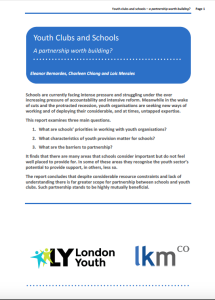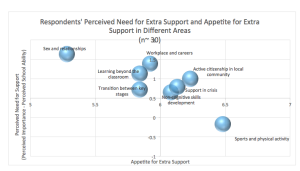Youth clubs and schools – a partnership worth building?
5th April 2016
 Teachers are too busy. Everyone knows that. But could it be because they’re trying to do too much and could youth clubs lend a helping hand? Our new report published today with London Youth suggests they could.
Teachers are too busy. Everyone knows that. But could it be because they’re trying to do too much and could youth clubs lend a helping hand? Our new report published today with London Youth suggests they could.
At a time when we are bombarded with examples of schools struggling with the pressures of accountability and reform, the youth sector is struggling with cuts and the protracted recession. Our report therefore asks:
- What are schools’ priorities in working with youth organisations?
- What are the characteristics are schools looking for in youth provision?
- What are the barriers to partnership?
We found there were a number of things like ‘sex and relationships education’ that teachers and schools considered important but did not feel well placed to provide. Our report argues that these are the sorts of things youth clubs and youth workers could help out with. However, whilst schools already had an appetite for support from youth clubs in some of these areas, in others we argue that youth clubs need to do more to make their case.
“Schools definitely have an agenda of more pastoral support such as careers guidance, but they have little or no funding to be able to provide that.”
– Deputy head teacher, secondary academy, Bedfordshire


We found that the areas of both highest need and highest appetite (quick wins) were:
- Opportunities to be active citizens in their local communities
- Access to support in periods of crisis
- Opportunities to develop certain ‘non-cognitive’ skills such as resilience and creativity.
The areas of high need, but lower appetite (development potential) were:
- Opportunities to learn about sex and relationships
- Support with transitions to the workplace and careers
- Opportunities to learn in a different setting (outside of the classroom)
- Support with transitions between key stages and phases
Whilst our analysis was clearly based on a small sample it certainly suggests there are unmet gaps which need to be explored further.
Barriers to provision
Unfortunately, there are six key barriers to partnerships at the moment. Some,
like information and knowledge about the offer, are relatively easy to address, whilst others are more challenging, for example resourcing, quality and differences of approach.
 Ultimately however, given that schools and youth organisations have so much to gain from greater partnership, we believe it’s time the two
Ultimately however, given that schools and youth organisations have so much to gain from greater partnership, we believe it’s time the two
sectors came together to discuss their differences, needs and priorities. Only then can they start trialling new approaches to partnership that help both sectors better support children and young people’s transition to adulthood.
Read the full report here: “Youth clubs and schools: a partnership worth building”


Comments